All the PCIe 5.0 SSDs Coming Out in the Next Year or So
We finally have some model names for upcoming PCIe 5.0 drives.
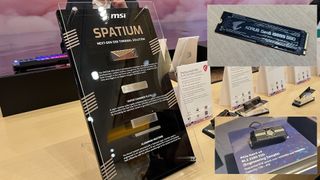
The world has been waiting for PCIe 5.0 SSDs to arrive since Intel's Alder Lake CPUs, the first to support the standard, launched in 2021. We passed through 2022 without a non-Enterprise PCIe 5.0 drive available for purchase, but 2023 seems like the year when consumer SSDs will start shipping.
At CES, we saw five different PCIe 5.0 SSDs that are supposed to ship in the foreseeable future, albeit in many cases not until quite a bit later in the year or perhaps early next. The companies showing off the drives were those not known for making their own controllers or NAND so most of the drives rely on the Phison E26 controller that we benchmarked recently. One of them will work with the Silicon Motion (SMI) SM2508.
| Brand | Model | Controller | Rated Speeds (seq red / write) | Due Out |
|---|---|---|---|---|
| Adata | XPG (model name TBD) | Silicon Motion SM2508 | 14,000 / 12,000 MBps | Possibly 2024 |
| Gigabyte | Aorus Gen5 10000 | Phison E26 | 12,000 / 10,000 MBps | Row 1 - Cell 4 |
| MSI | Spatium M570 Pro | Phison E26 | 12,000 / 10,000 MBps | Q2 or Q3 |
| MSI | Spatium M570 | Phison E26 | 10,000 / 10,000 MBps | Q2 |
| Patriot Memory | Unnamed PCIe 5 SSD | Phison E26 | Row 4 - Cell 3 | Row 4 - Cell 4 |
PCIe 5.0 Controllers
Most of the drives we've seen rely on the Phison PS5026-E26 (or E26 for short). This 12nm controller has 8 channels and promises up to 2400 MT/S with a theoretical maximum sequential read speed of 14,000 MBps and a sequential write speed of up to 11,800 MBps. None of the drives is rated for speeds quite that high.
The Phison E26 also boasts up to 1.5 million read IOPS and 2 million writer IOPS. To achieve maximum speeds, a drive would have to have ideal firmware and very fast NAND flash.
All of the Phison-powered drives are paired with some kind of 232-layer Micron NAND flash. Any drive which touts a read speed of 10,000 MBps uses the 1,600 MT/s flash, which is due out in Q2. Those with 12,000 MBps reads use the 2,000 MT/s flash which is targeted for late Q2 or early Q3. And those with 14,000 MBps reads need the 2,400 MT/s flash which may come out as late as Q4.
Silicon Motion's 8-channel, 12nm SM2508 controller touts up to 2 million read and write IOPS. It also promises up to 14,000 MBps reads and 12,000 MBps writes.
MSI Spatium M570 Pro / Spatium M570
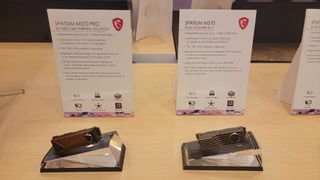
MSI is coming out with two different SSDs based on the Phison E26 controller. The MSI Spatium M570 Pro combines the E26 with Micron's speedy, 2,000 MT/S NAND flash memory. It touts sequential read and write speeds of 12,000 / 10,000 MBps. The slower, Spatium M570 uses the 1,600 MT/S NAND and is rated for a read speed of only 10,000 MBps.
Stay On the Cutting Edge: Get the Tom's Hardware Newsletter
Join the experts who read Tom's Hardware for the inside track on enthusiast PC tech news — and have for over 25 years. We'll send breaking news and in-depth reviews of CPUs, GPUs, AI, maker hardware and more straight to your inbox.
The M570 Pro has what MSI calls a "next-gen thermal design," with a finned heatsink on top of a flat vapor chamber plate and covered with a geometric shroud. The M570 non-pro has a bronze-colored aluminum heat sink with fins but no vapor chamber. Both drives will be available in 1, 2 or 4TB capacities.
At CES, we got a look not only at MSI's two upcoming PCIe 5.0 SSDs, but we actually got to see some CrystalDiskMark benchmarks of the faster, Spatium M570 Pro in 2TB capacity. Attached to a desktop with high-end specs, the M570 Pro returned sequential read and write speeds of 12,342 and11,814 MBps respectively, which are even higher than the specs. It also had pretty good random 4K numbers as you can see in the screenshot below (should you need to capture your own pics of benchmarks, see our story on how to take screenshots in Windows 10 or 11).

The Spatium M570 is due out in Q2 and the M570 Pro will come later, perhaps still in Q2 or in Q3. No word on pricing.
Adata XPG PCIe 5.0 SSD
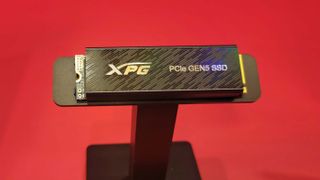
At CES, Adata showed off an as-yet-unnamed PCIe 5.0 SSD to be launched under its XPG gaming brand. The XPG SSD is the only one we've seen that will use Silicon Motion's SM2508 controller. It's rated for an impressive 14,000 / 12,000 MBps reads and writes. If it meets the controller's specs, it will also deliver 2 mullion read and write IOPS.
To keep it from overheating, the drive will have a metal heatsink with a fan in it and a stainless steel base plate.
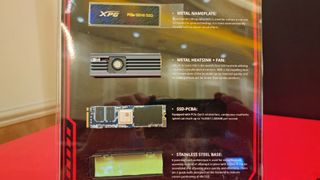
Adata has not announced what type of NAND flash it plans to use with the drive nor did it give an estimated release date. However, SMI reps told us that the SM2508 won't begin mass production until 2024 so, if that's correct, the XPG drive couldn't come out until then.
Gigabyte Aorus Gen5 10000 SSD
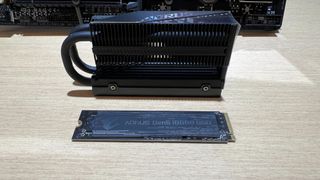
Gigabyte was one of the first -- perhaps the first -- to announce a non-enterprise PCIe 5.0 SSD when it disclosed the Aorus Gen5 10000 SSD last summer. It's still not out yet and Gigabyte did not offer a proposed release date when we met with them. However, we'd expect it to launch around the same time as MSI's Spatium M570 Pro, as both have the same components.
Just like the Spatium M570 Pro, the Aorus Gen5 10000 touts read and write speeds of 12,000 / 10,000 MBps. And like MSI's drive, this one will use Micron's 2,000 MT/s NAND.
It comes with either a huge heat sink or without one.
Patriot Memory Unnamed SSD

Patriot also has a PCIe 5 SSD based on the Phison E26 controller and 2,000 MT/S NAND. It has no model name, but it touts the same 12,000 / 10,000 MBps speeds as the Spatium M570 Pro.
The sample we saw at Patriot's CES booth had a giant heatsink and fan on it, but it looks very unfinished so we imagine that there'd at least be some kind of attractive cover above the fan. It will be available in 1 to 4TB capacities (which we think includes a 2TB capacity in there).
No word on availability for the Patriot drive.
-
TechieTwo What an embarrassment that delivery of the PCIe 5 SSDs are almost a year late. Thankfully most of these SSDs do not require the stupid mile-high heat sinks. Typical low profile mobo supplied heatsinks are reported to work fine and not cause any throttling on the better drives.Reply -
USAFRet Reply
Why is this an "embarrassment" ?TechieTwo said:What an embarrassment that delivery of the PCIe 5 SSDs are almost a year late. Thankfully most of these SSDs do not require the stupid mile-high heat sinks. Typical low profile mobo supplied heatsinks are reported to work fine and not cause any throttling on the better drives.
A year late from what? -
peachpuff We don't need more speed we need bigger sizes, these don't decrease load times of the os/game at all so whats the point of them getting faster all the time?Reply -
bit_user @apiltch , I couldn't comment on the main CES blog/article, but I wanted to thank you & your staff for the excellent show coverage!Reply -
bit_user Reply
Or, another way to look at it is that Intel was more than a year early in adopting PCIe 5.0!TechieTwo said:What an embarrassment that delivery of the PCIe 5 SSDs are almost a year late.
If we rewind back to AMD's introduction of PCIe 4.0, there were drives that supported the interface that showed up sooner, but it took over a year since Ryzen 3k's launch for any PCIe 4.0 SSD to meaningfully exceed PCIe 3.0 speeds! -
bit_user ReplyMost of the drives we've seen rely on the Phison PS5026-E26 (or E26 for short). This 12nm controller has 8 channels ...
So glad this isn't TSMC N7, as that means there's probably some potential for power savings. Perhaps I'll wait until a N7 or N6-based controller is released. Until then, I'm sure PCIe 4.0 would suit me just fine. -
PlaneInTheSky Cooling fans on SSD? Is this some kind of joke. I don't even want one for free if they get that hot.Reply
Only thing I want from SSD is more data for lower prices.
I couldn't care less how many gigabytes the sequential read speed is. It's completely irrelevant for regular consumers. -
PlaneInTheSky Replythese don't decrease load times of the os/game at all
Yup, game loading time has nothing to do with the speed of SSD anymore. (yes going from HDD to SSD decreased loading times significantly, but it stopped there, faster SSD are irrelevant).
Loading times in games are caused by:
decompression, responsible for about 30% of loading times
drm like Denuvo, responsible for about 40%-60% of loading timesThe first one can be fixed because developers will start to support Nvidia's GDeflate, where the GPU will do hardware decompression instead of the CPU.
The last one is a DRM issue and calls to Denuvo DRM servers during loading won't get any faster regardless of which hardware you have. When Denuvo is stripped from games, they tend to load significantly faster.
Articles claiming that DirectStorage and faster SSD will give PC loading times equal to PS5 are clueless. Loading times in games are caused by decompression and DRM. PS5 fixed both. PC can fix decompression but PC can not fix DRM the way it is implemented now. DRM checks on PS5 are internal with a dedicated chip, on PC it requires calls to online DRM servers, many slow back and forth handshakes and it relies on the CPU and network to do all those checks.
ByfLg9wGB4o -
bit_user Reply
Or just use a faster compression method, like ZStd.PlaneInTheSky said:The first one can be fixed because developers will start to support Nvidia's GDeflate, where the GPU will do hardware decompression instead of the CPU.
LOL @ using GPUs for decompression! That's got to be one of the least-efficient things you can do on a GPU!
Most Popular




